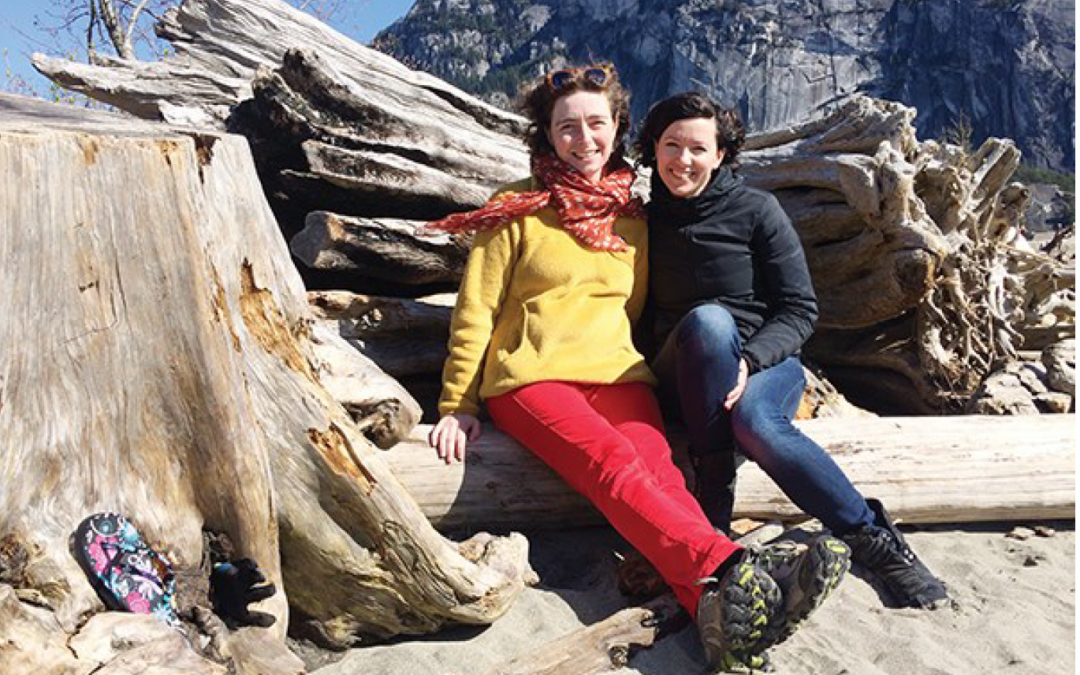

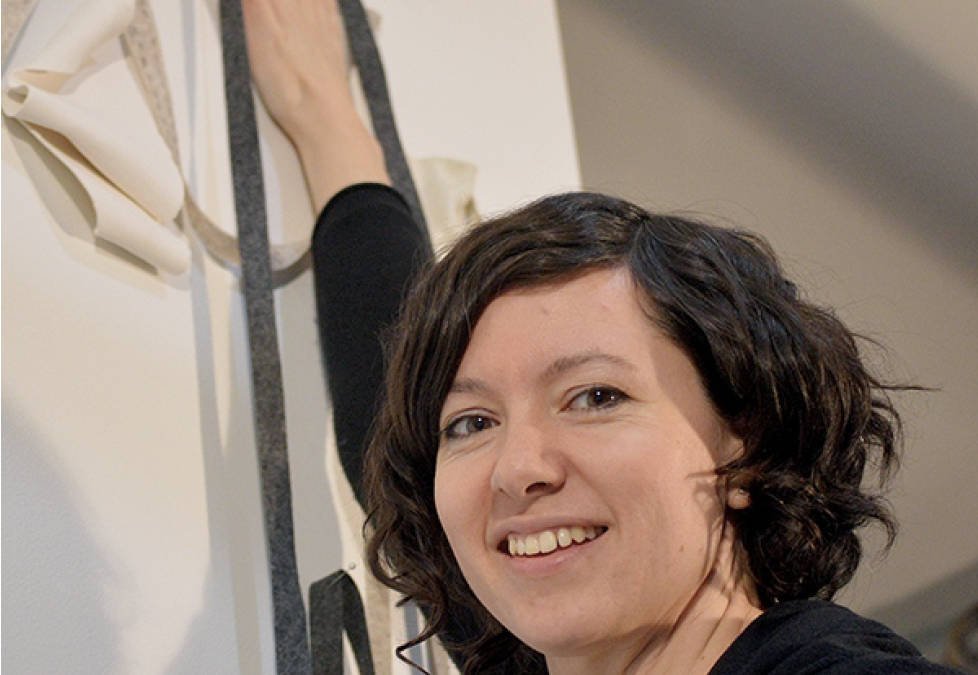
Inspiring creativity. Artists in residence give quest students fresh perspectives on art.
Chief-InspiringCreativity-1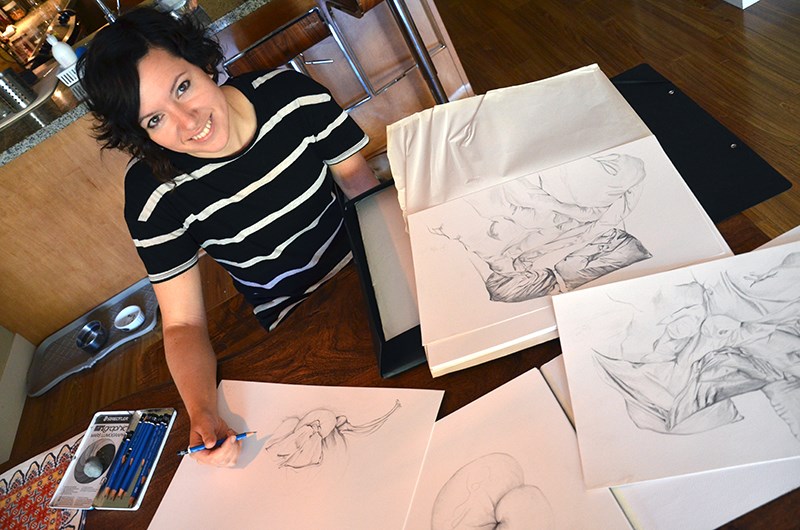
The Memory of Touch; Squamish artist gifted grant to explore the way the body remembers
The-memory-of-touch-Squamish-Chief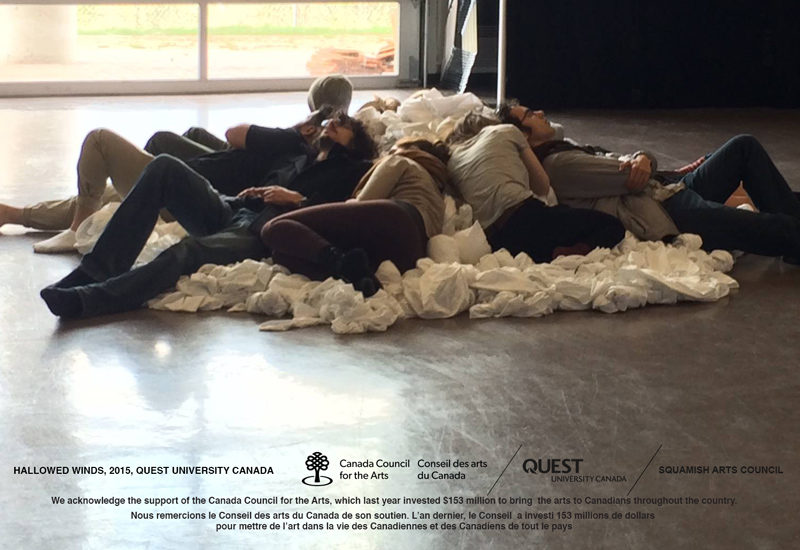
HALLOWED WINDS – Quest University
31 March- 4 April 2015
MPR Quest University
Squamish BC Canada

Referenced Works

From the Transart Website: Quest University Canada invites Transart Alumna as Artist in Residence for “Hallowed Winds”
Post available : http://www.transart.org/quest-university-canada-invites-transart-alumna-as-artist-in-residence-for-hallowed-winds/
Quest University Canada
Laurel Terlesky: Artist-In-Residence
Quest University’s Artist-in-Residence program is pleased to welcome Laurel Terlesky MFA, Transart alumna, as artist-in-residence this March. Together with students, faculty and staff, Terlesky will be creating an installation, Hallowed Winds. The exhibition will be open to the public March 31 – April 3, 2015.
Hallowed Winds is an installation that explores the imprint of touch in our memory and how the body leaves its trace in materiality. This installation will create a shared experience between participants activated by the ephemeral audio narratives evoking an awareness of the felt body.
As part of her residency, Laurel Terlesky will teach a course at Quest University titled “Art, the Body and Technology”. The course will provoke a dialogue amongst students to reveal the spaces and intersections of physical perceptual and sensory driven awareness, cyberspace, the networked nodes of our social community and reflect upon how technology shifts the ways we inhabit our physical landscapes and interior environments.
About Quest’s Artist-in-Residence
Quest University Canada’s artist-in-residence program is open to artists in any discipline, including, but not limited to, visual art, dramatic art, creative writing, dance and music. The artists in residence offer courses in their craft and in the creative process, and provide students with opportunities to develop creative and artistic skills. Additionally, the artists share their own work with the University and surrounding community through installations, exhibitions, or events. Resident artists normally come to Quest for either 6 weeks or 12 weeks between September and April, teaching one or two courses respectively. The remainder of the time is dedicated to the support and practice of both the artists’ and students’ work, which may include open studio sessions, performance/exhibition of artist’s work, and other activities. We offer visiting tutor status, accommodation, and compensation for the entire residence period. We will attempt to accommodate the specific needs of your artistic genre within the constraints of our limited resources.
Quest University Canada
3200 University Boulevard
Squamish, Canada
www.questu.ca
https://laurelterlesky.ca
http://www.transart.org/people/laurel-terlesky/

Pique Article: Artist Terlesky makes her mark with Quest course
Pique Article: http://www.piquenewsmagazine.com/whistler/artist-terlesky-makes-her-mark-with-quest-course/Content?oid=2569766
PDF Print: Artist Terlesky makes her mark with Quest course _ Arts _ Pique Newsmagazine _ Whistler, CANADA
Artist Terlesky makes her mark with Quest course
Telling a story through art is aim of six-week continuing education program
One of the most powerful images in art is a handprint, the outline of a human hand painted 32,000 years ago on the walls of Chauvet Cave in France.
Director Werner Herzog captured the image, which shows the world as seen by Paleolithic humanity, in his documentary Cave of Forgotten Dreams.
What comes through is the power of mark making. Drawing who we are turned us into cognizant beings that recorded our lives. The cave painter may not have known this, but it still impacts us today.
Squamish artist Laurel Terlesky is offering a course, Locating Narratives in Mark Making, at Quest University, as part of its continuing education program. It runs on Tuesdays, from Oct. 14 to Nov. 18, from 7 p.m. to 9 p.m. Course fees are $185.
She wants her students to tell stories through drawing, tapping their sensory awareness through pencils and charcoal, sounds, actions and other materials.
“My focus is creative practice in my own work. I look and I work with materials and make inquiries through materials,” says Terlesky. “We’re focused on drawing in this course, but through interacting with charcoal or pencil on the paper, what can we further learn about ourselves and our mediation of how we see the world and how we interact with things in the world.”
Originally from Calgary, Terlesky has been an artist for years, her paintings gracing walls around the region, including Whistler.
She had also taught visual effects for media at BCIT in Vancouver and was an advisor to an arts program on CBC Radio.
But her interests evolved.
“My work has shifted a lot in the last two-and-a-half years because I’ve been doing more… my goal with my degree was to merge my media background with fine arts. I’ve feel I’ve definitely entered the realm where I can hold the title ‘artist’ more,” she says.
She recently received a Master of Fine Arts degree in Creative Practice from Transart Institute (located in Berlin and New York), but taken at the University of Plymouth in England.
Terlesky’s creative practice explores knowledge through the generation of objects.
An example of this is her most recent installation, Ouch, which was on display at the Beaumont Studios in Vancouver this past spring.
Ouch is a large box covered in white plastic, “the same material an iPhone is made with.” There are holes in the top of it spelling brail for “ouch.” Stuffed into the holes are soft nylon stuffed cotton forms, which Terlesky calls “polyps.”
Terlesky put out a call through social media for people take their iPhones or recorders and record themselves saying “ouch.” This went into the piece’s audio track.
“I wanted to look at how our social networking works. We’re on computers all the time, we’re talking through Skype, we’re emailing more. What are we losing by not being face-to–face with somebody? I’m interesting in looking at that,” she says.
“My initial research this year was to work with the intersections of vulnerability, technology and empathy. I used these materials while I was speaking to people. It’s a tactile dialogue about the exchange between us.”
In 2013, Terlesky worked with 10 motherless daughters, creating an installation on their loss.
She says about the experience: “I realized that doing a process like this you could work through trauma in certain ways, (it could mean looking at ) mental health or (you could) just widen people’s lives to make it a bit more interesting and deeper. Understanding sensitivities, things that give you a better understanding of yourself.”
Along with the course, Terlesky will be artist-in-residence at Quest University in February and March, and will be building an installation with the students.
For more information visit www.questu.ca/sub/continued_Education_2014/continuing-education.html.
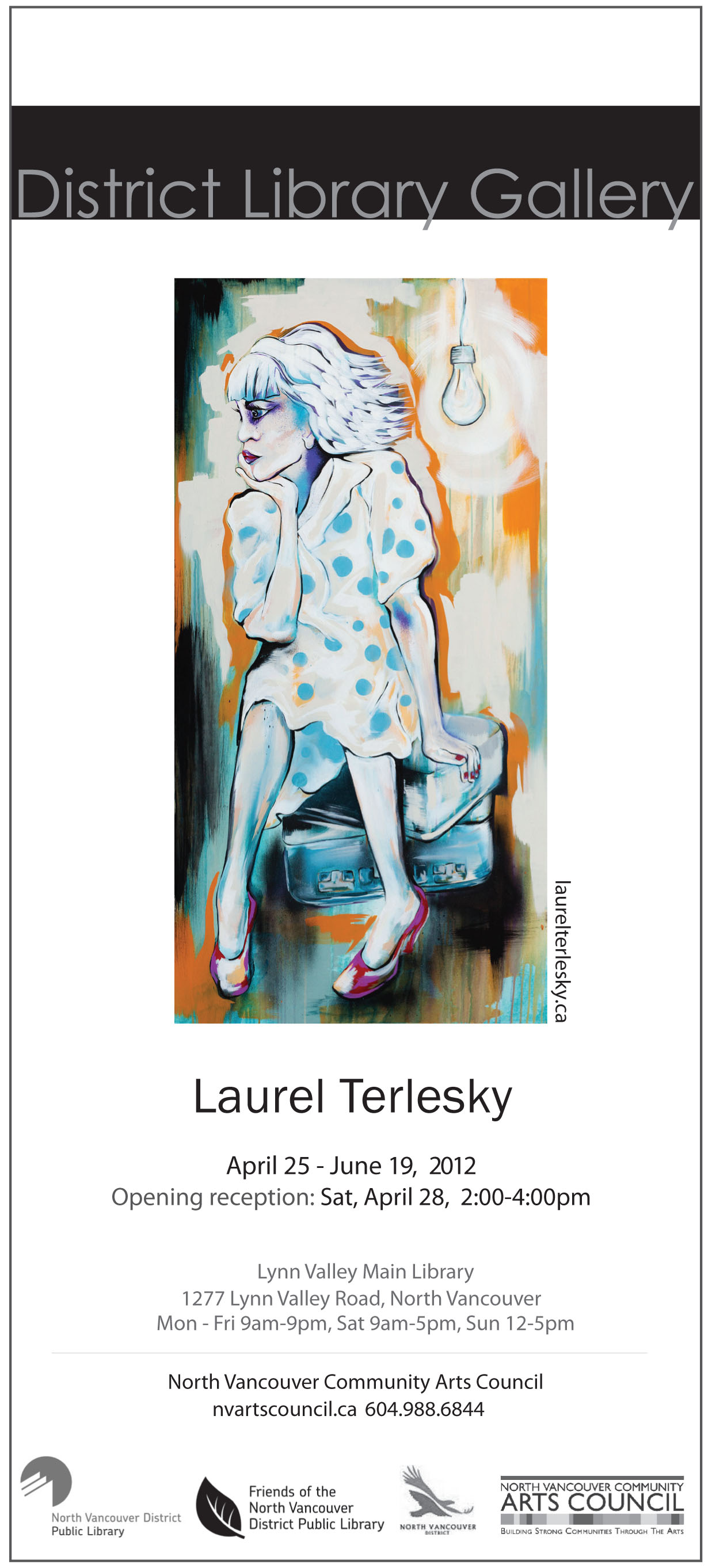
“We Love this Stuff so Much…” exhibit at the Lynn Valley Public Library presented by the North Vancouver Arts Council
 The North Vancouver Community Arts Council is proud to present
The North Vancouver Community Arts Council is proud to present
District Library Gallery
Lynn Valley Main Library
1277 Lynn Valley Road, North Vancouver
Apr 25-June 19, 2012
Opening Reception: Sat, Apr 28, 2:00-4:00pm
Laurel Terlesky
Through a surrealist pop culture approach to portraits, Laurel explores our dependency on electricity and power and the future
of sustainable energy practices. Created on large canvas using oil, acrylic and aerosol she presents electricity as part of the human sense of self.
After travelling through the United States, tapping into the touch-and-go atmosphere of pop culture from New York to San Francisco as well as footing through a handful of Canadian cities from Montreal to Vancouver, Laurel made her home in Squamish, BC. She completed her Bachelor of Fine Arts Degree with a major in Painting from the University of Victoria in 1999 and has been actively creating and contributing to the artistic community in which she surrounds herself.
District Library Gallery
Lynn Valley Main Library,
1277 Lynn Valley Road, North Vancouver
Mon-Fri 9am–9pm, Sat 9am–5pm, Sun 12-5pm
North Vancouver Community Arts Council
335 Lonsdale Avenue, North Vancouver, BC 604.988.6844 www.nvartscouncil.ca
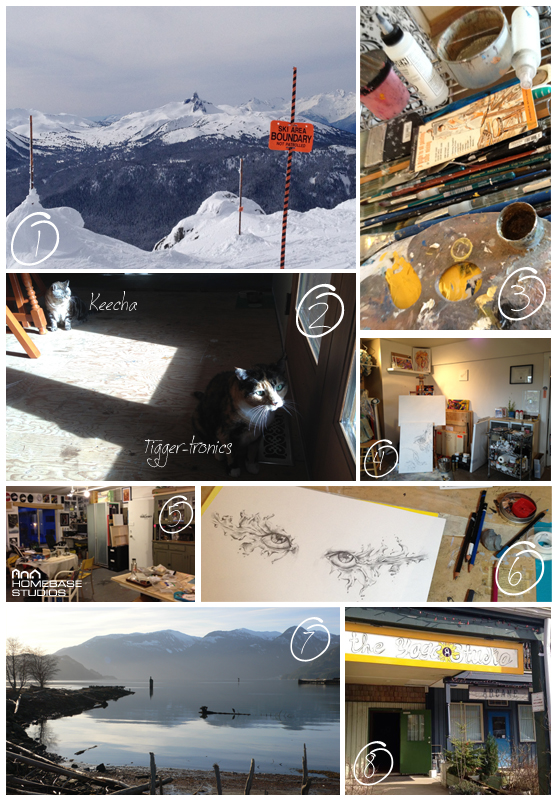
The Proof – Whistler is Awesome Feature
Whistler is Awesome just posted this feature:
http://www.whistlerisawesome.com/category/proof/
 |
The Proof: Laurel Terlesky
Laurel Terlesky is more than an artist – she’s a visual architect representing our current relationship to nature, ourselves, modern behaviors, and that in which we are environmentally dependent on for source. There’s a beautiful struggle shown in her work – The striking of a fluidity in the inter-dependence of the modern world and our most natural state. By plugging in we can become unplugged, and she displays there’s a fine balance between the two. We are in need of the contemporary tools of electronics and media to communicate our ideas, but in the process, as a society, this disconnection can be the very demise of us. Terlesky’ s images tell the tale that unplugging from nature can leave us in a desperate state, but by plugging into it with partnership strikes the cord of true connection. ~Kate Power, founder, Fleet Jewelry. (Fleetjewelry.com)
The Photos
01 I like to start my day by living near the boundary. A snowfall the night before makes for an especially wonderful morning.
02 My two beauties share some loving with me throughout the day… morning cuddles are the best! (Keecha (Kitten in Ukrainian, a lynx point Siamese.) and Tigger-tronics (earned her nickname because she likes to hang out near speakers when electronic music is on. Tried recording her purr once and turned that into some electronic sounds).
03 Creativity gets underway daily at my studio on 2nd Ave in downtown Squamish.
04 Things are constantly changing in the studio – keeps me inspired!
05 Homebase Studios is next door to my space – it’s a shared space with resident artists Stan Matwychuk, Kevin Su, Amber Butler and Sanaz Busink. We hold events and workshops here. Drop by anytime!
06 Getting new works together exploring themes around water. This subject will be my focus for the next two years as I complete my MFA degree where I will be combining my new media & painting practices for some new pieces.
07 I live in such a beautiful place – where the water meets the mountains. In the afternoons I take a short break for a walk or run around Nexen beach.
08 The best days are when I finish off with a class at The Yoga Studio. Some of my favourite yoga teachers make their magic here. Thanks Sarah, Lydia and Chris.
The Questions
What neighbourhood do you live in?
Squamish (more precisely Garibaldi Highlands)
What do you do and where?
Artist: Painting, Drawing and New Media. I also freelance mainly in motion graphics for tv & film, and also website & print design. I also teach new media at BCIT in Vancouver. Most days I can be found at my studio #204 37760 2nd Ave Squamish. Stop by any time for a visit.
What are you working on?
Getting a few things ready for some upcoming exhibitions. Starting to experiment on some new works combining projection and painted surfaces. Also gearing up to start my MFA this summer which will take me to Berlin and New York a few times over the next couple of years.
Where can we find your work?
Until the end of March at Raw Canvas in Yaletown (1046 Hamilton St., Vancouver), mid-April until mid-June at the Lynn Valley Main Library (North Vancouver) and hopefully State of the Art, (although that isn’t confirmed yet – fingers crossed!). Lastly, always at my studio and on my website: laurelterlesky.ca
- Written by: Kassia OConnor |
- Category: Art,The Proof |
- Tagged: Art, Homebase Studios, Laurel Terlesky, squamish, The Proof |
- Comments: 0




